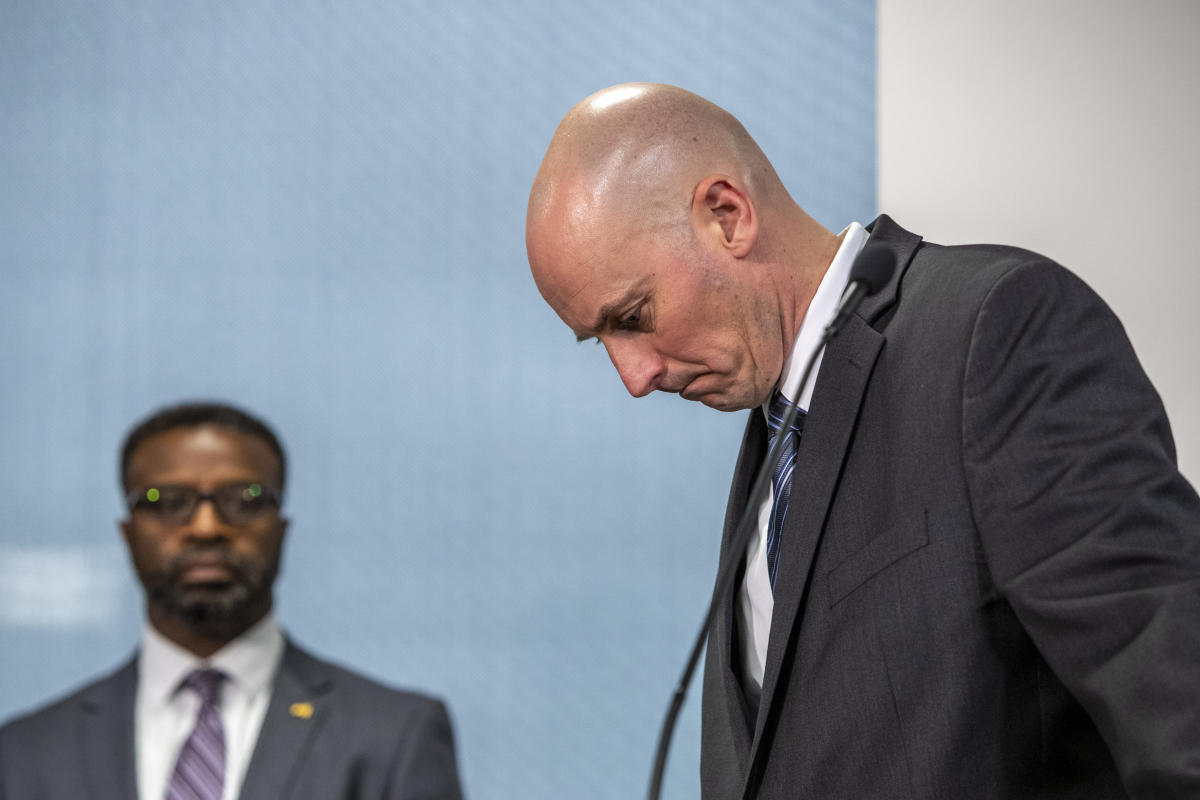
Patrick Lyoya’s father says he and his family have a right to know the name of the white officer who fatally shot the 26-year-old Black man.
But the police chief in Grand Rapids, Michigan, says he will only do so if the officer is charged in the April 4 shooting that followed a brief foot chase and a struggle over the officer’s Taser.
Eric Winstrom’s department is among those across the U.S. that have faced scrutiny for withholding identities of officers in cases where Black people were wounded or killed during interactions with police. Some have said it’s to protect the officers from retribution. Others, like Grand Rapids, point to policies that prohibit the release of an officer’s name before charges are filed.
“I’m asking for the law to release his face, his image and his identification because I would love to know the person who has killed my son. I have the right,” Peter Lyoya said through a translator during an emotional news conference after video of the shooting of his son was released last week.
Andrew Shannon, president of the Southern Christian Leadership Conference Peninsula Chapter and vice president for the SCLC Virginia State Unit, said police departments should treat officers who are under investigation like they would anyone else.
“They always report who the suspect is and they report who the victim is, except in cases of rape,” Shannon told The Associated Press. “There should be no special treatment when law enforcement are involved in these types of matters. They should want to demonstrate transparency and openness so everyone can be fully apprised of the process.”
Lyoya was facedown on the ground when an officer shot him in the back of the head while straddling Lyoya. The officer had stopped Lyoya for driving with a license plate that didn’t belong to the vehicle.
The funeral for Lyoya, a native of Congo, is scheduled Friday in Grand Rapids, about 150 miles (240 kilometers) northwest of Detroit. The Rev. Al Sharpton is scheduled to deliver the eulogy.
While Winstrom said he could not release the officer’s name, he did release videos of the shooting, citing a need for transparency. The officer could be heard repeatedly ordering Lyoya to “let go” of his Taser, at one point demanding: “Drop the Taser!”
Ben Crump, an attorney for Lyoya’s family, planned to release results of an independent autopsy on Tuesday.
Michigan State Police are investigating. The prosecutor who will determine whether the officer will face any charges has said not to expect a quick decision.
A Grand Rapids police spokeswoman said Monday in an email that a person’s name, age, other basic information and the charges against him can be released following an arrest or issuance of an arrest warrant.
“Not releasing the officer’s name is consistent with” the procedure, Jennifer Kalczuk wrote.
Such policies vary from city to city.
Chicago, for example, changed how it handles such cases after Black teenager Laquan McDonald was shot 16 times by a white police officer in October 2014. In that case, it was prosecutors who released Officer Jason Van Dyke’s name — 13 months later, when he was charged with murder and video for the shooting was also released. On Monday, Federal authorities said they will not criminally charge Van Dyke.
In response to criticism of how the McDonald shooting was handled, the city made changes. While police still will not release an officer’s name unless he’s charged, the agency that reviews those shootings does so regardless. City policy also requires that video be released within 60 days.
Last year, within a month of two separate fatal shootings by police, including of a 13-year-old boy, the Civilian Office of Police Accountability released officers’ names. Prosecutors have said the officers won’t face charges.
Ephraim Eaddy, spokesman for the agency, said it has concluded that officers’ names cannot be held back because they are public servants.
If the release of the names of the Chicago officers involved in the two 2021 shootings seemed to come quickly, the name of the Kenosha, Wisconsin, police officer who shot Jacob Blake several times in 2020 was made public in lightning speed.
Three days after that shooting, the Wisconsin Department of Justice issued a news release that included Officer Rusten Sheskey’s name.
The decision came after the Kenosha Police Department handed the investigation over to the state’s Justice Department “for complete transparency,” said Kenosha police Lt. Joseph Nosalik.
Nosalik said he agreed with the decision. Had the department refused to release the name, Nosalik said he would have called to ask why.
“The public has a right to know … and unless there’s a logical reason like it might put the officer’s safety and his family in jeopardy, I don’t see a reason why the name can’t be released,” he said.
In fact, he said, the Kenosha police moved to “extricate” Sheskey’s family from their home after learning that they might be in danger, and suggested the same concern might be part of the reason why authorities in Grand Rapids have not released the officer’s name.
Crump, the Lyoyas’ attorney, said having the officer’s name would allow the family to find out more about him.
“We want to know his history,” Crump said last week. “I can guarantee you, they’re going to do everything in their power to try to learn the history of Patrick to assassinate his character.”
_____
Find the AP’s full coverage of the fatal police shooting of Patrick Lyoya: https://apnews.com/hub/patrick-lyoya
____
Williams reported from West Bloomfield, Michigan. Babwin reported from Chicago. Williams is a member of AP’s Race and Ethnicity team.




